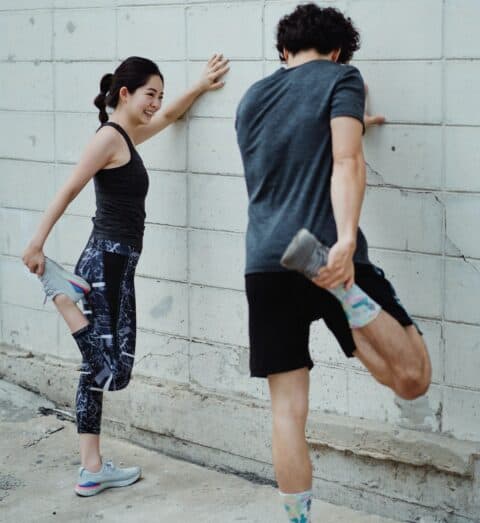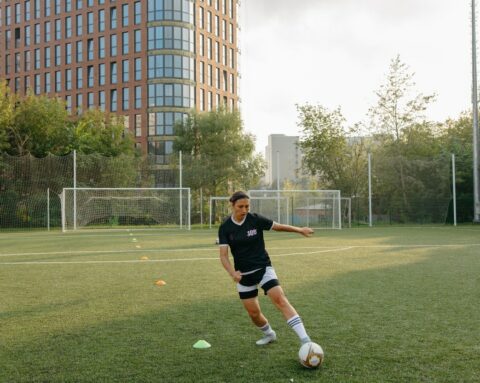The Calf Tear
The gastrocnemius and soleus muscles make up the two muscles at the back of our lower leg that when pulled is diagnosed as a strained calf. The calf is located behind the tibia and works across both the knee and ankle joints. It extends from the femur behind the knee to the calcaneus. The muscle inserts into the Achilles tendon along with other muscles and is responsible for assisting in flexing the knee and movements that point the toes away from the body. The main reasons that can cause a calf muscle tear or strain to occur are through acceleration or changes in direction. It is, however, possible that you can strain your calf muscle simply by walking. There are three different grades to speak about when referring to calf tears with grade one being minor and grade three the most severe.
Gradings
A grade one calf muscle tear usually occurs from a mild overstretch of the muscle resulting in very minor tears to the fibre. In the first few days, you may notice symptoms that impact your mobility quite heavily and recovery takes approximately one to two weeks if you rehabilitate your injury properly.
Grade two is described as a partial tear of the calf muscle fibres. Grade two is a bigger deal than grade one and as a result, requires several weeks of physical therapy and proper rehabilitation. Returning to your usual activities without the guidance of a physical therapist can be extremely risky and may cause an unnecessary lengthening of the injury.
The most severe of the calf tears is the grade three calf strain. The grade three rupture is a complete tear of the muscle fibres in the calf. If you have any inclination that you may have a major calf tear it is imperative to have it checked as soon as possible. This is usually verified with an MRI or ultrasound. The recovery time for a grade three calf tear is usually several months and then extensive rehabilitation is required to improve the muscle to somewhere close to 100% health.
If you experience any more serious signs such as rapid pulse, feeling dizzy faint or lightheaded, shortness of breath, chest pain or coughing up blood, it may be a sign of a more serious condition such as Deep Vein Thrombosis and it is important to seek medical attention as soon as possible. As always, your specialist therapist at Studio Musculoskeletal will provide expert treatment and guidance no matter what your grading is.
Rehabilitation Of The Calf Tear
During the initial phase of your calf injury, it will be difficult for you to walk without a limp. As a result, the best technique to treat this soft tissue injury is with rest, ice, compression and elevation (RICE.) You will be required to avoid putting wait on the muscle where possible and in some cases, a walking boot or crutches may be required during the early stages to reduce pain and inflammation.
In the second stage of recovery, your body will begin to repair itself and regain its full range of motion. This can take up to six weeks and depending on the severity of your injury there are other steps that must be undertaken such as remoulding your scar tissue to prevent reinjury in the future. Massage is one of the best ways to successfully rehabilitate your injury through lengthening and orientating the scar tissue. Once you are able to walk without a limp and perform activities such as calf stretches you can be confident that you have full extension of your soft tissue once more.
Now it is time to focus on the power being generated by your calf muscle. As with most muscle strengthening scenarios, it is important to start weightless, and progress through to resistance loaded exercises over time. Your therapist and Studio Musculoskeletal will be vital in ensuring this stage is dealt with appropriately to avoid reinjury. This stage may also include the strengthening of your other leg muscles which have not been in use during the recovery.
To fully restore your power, speed and agility it is important to undergo an eccentric training regime. An eccentric training plan will focus on the power in the muscle utilised when your calf moves in a downward trajectory. With the majority of calf injuries occurring during moments of high speed and intensity, it is important to add some sport-specific training exercises into your rehabilitation program to prepare you for a return to action.
Return To Sport
Finally, it is time to return to your sport of choice. Your myotherapist will guide you on exactly how you should look to re-enter the game and will focus on ensuring your progression does not lead to reinjury. Whilst your rehabilitation could last anywhere from days to months, there will always be specific time frames and goals for you to hit that will maximise your functionality when you finally return to play.
Whatever the severity of your injury you can be absolutely certain the Studio Musculoskeletal team will use our state-of-the-art equipment, knowledge and techniques to assist with your calf tear in the most efficient and effective ways possible. If you have experienced any of the symptoms mentioned in this article it is important to get in touch with us as soon as possible.






